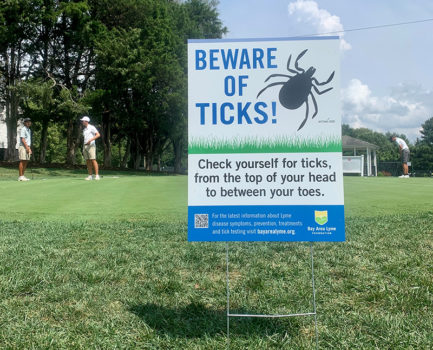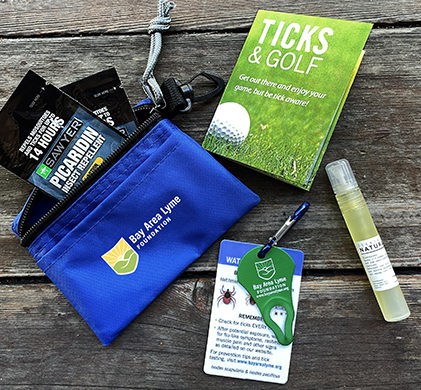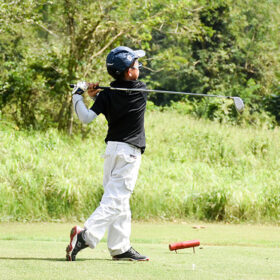BAL Happenings Series
Promoting tick bite prevention and educating everyone about the serious health impacts of tick-borne diseases has been a consistent objective for Bay Area Lyme Foundation. After all, although the foundation’s mission is to make Lyme disease easy to diagnose and simply to cure, it would be so much better if nobody ever got bitten by an infected tick in the first place. But as ticks continue to proliferate and the number of people impacted by Lyme and tick-borne diseases grows, the need for tick bite prevention and education escalates accordingly. That’s why the foundation is excited about its three-year partnership with the American Junior Golf Association (AJGA), and an upcoming announcement with PGAJR, as they provide an unprecedented opportunity to reach thousands of young athletes and their families.
But why are golf courses high risk locations for tick bites? After all, the fairways are mown regularly, and golfers are typically walking around on grass that is short and frequently tended. Surely hiking, mountain biking and running in areas where trails are overgrown and you’re outside at times when infected ticks are most active would be higher risk?
 The startling reality is that a golf course is the perfect habitat for ticks to thrive. In fact, according to the research presented at the American Public Health Association in 2014, nearly 25% of golfers were diagnosed with Lyme disease and yet 72% of golfers did NOT use any insect repellents. Ticks flourish in areas between woodlands and open spaces, living on the small forest animals that thrive and in this terrain. The grasses and “rough” areas surrounding groomed fairways provide homes for rabbits, ground squirrels and other small mammals who are the known reservoir hosts for Borrelia burgdorferi, the bacteria that causes Lyme. Ticks feed on these small mammals and become infected, then may go on to bite unsuspecting humans who just happen to be in the vicinity.
The startling reality is that a golf course is the perfect habitat for ticks to thrive. In fact, according to the research presented at the American Public Health Association in 2014, nearly 25% of golfers were diagnosed with Lyme disease and yet 72% of golfers did NOT use any insect repellents. Ticks flourish in areas between woodlands and open spaces, living on the small forest animals that thrive and in this terrain. The grasses and “rough” areas surrounding groomed fairways provide homes for rabbits, ground squirrels and other small mammals who are the known reservoir hosts for Borrelia burgdorferi, the bacteria that causes Lyme. Ticks feed on these small mammals and become infected, then may go on to bite unsuspecting humans who just happen to be in the vicinity.
Tick behavior is not very sophisticated: they simply hang out in the grasses and wait, patiently, for any warm-blooded creature to cruise by—humans included. Contrary to popular belief, ticks don’t jump or leap onto humans, or drop from trees. They are absolute opportunists. If you happen to brush past a blade of grass where a hopeful tick is hanging out, it will latch onto your pants, quickly crawling up until it finds a break in your clothing. Its goal is to find a warm, moist spot on your body to embed itself and feed. Ticks also get activated by moisture, and the irrigation used to keep fairways green and in pristine condition for golfers unfortunately contributes to making golf courses the perfect hangout spots for hungry ticks. Another study conducted by the University of Rhode Island found that 50-75% of ticks found on nearby golf courses carried the bacteria that causes Lyme disease, so when you couple these statistics with young golfers whose stature places them closer to the ground, and whose skill levels mean they may spend a little more time searching for golf balls in the rough, it adds up to the perfect location for ticks seeking blood meals.
 Linda Giampa, executive director of Bay Area Lyme commented, “We are deeply concerned about young athletes involved in sports, such as golf, that put them at high risk for Lyme disease when they have not been fully educated about ways to prevent tick bites.” This partnership with the AJGA underscores Bay Area Lyme’s commitment to tick bite prevention as the foundation will provide education materials to the golf community. “Each AJGA member will receive a Bay Area Lyme tick kit which includes our prevention guide, a bottle of Sawyer Products Picaridin lotion, Tick Tock Naturals organic repellent spray and a Tick Key tick removal device with instructions on the correct way to remove an embedded tick,” she explains.
Linda Giampa, executive director of Bay Area Lyme commented, “We are deeply concerned about young athletes involved in sports, such as golf, that put them at high risk for Lyme disease when they have not been fully educated about ways to prevent tick bites.” This partnership with the AJGA underscores Bay Area Lyme’s commitment to tick bite prevention as the foundation will provide education materials to the golf community. “Each AJGA member will receive a Bay Area Lyme tick kit which includes our prevention guide, a bottle of Sawyer Products Picaridin lotion, Tick Tock Naturals organic repellent spray and a Tick Key tick removal device with instructions on the correct way to remove an embedded tick,” she explains.
 Nina Fairbairn is an investment partner who volunteers for Bay Area Lyme’s advisory board who happens to be an avid golfer. As a young athlete, she and her brother spent many hours playing golf both with the AJGA, then growing up through the ranks and tournaments to play Division 1 golf at Harvard University. “My brother and I wish we had been educated on the risks associated with Lyme disease and the prevalence of ticks throughout the US, and ways to prevent being bitten.” She adds, thoughtfully, “Few golfers seem to be aware of the risks and even fewer take precautions, and it’s imperative for us to change this.”
Nina Fairbairn is an investment partner who volunteers for Bay Area Lyme’s advisory board who happens to be an avid golfer. As a young athlete, she and her brother spent many hours playing golf both with the AJGA, then growing up through the ranks and tournaments to play Division 1 golf at Harvard University. “My brother and I wish we had been educated on the risks associated with Lyme disease and the prevalence of ticks throughout the US, and ways to prevent being bitten.” She adds, thoughtfully, “Few golfers seem to be aware of the risks and even fewer take precautions, and it’s imperative for us to change this.”
As Bay Area Lyme enters its tenth year of operation, much has been accomplished through its portfolio of innovative grants-based investment in medical research. Bay Area Lyme scientists have proved that chronic/persistent Lyme exists, that ticks are moving into new habitats around the nation, and that infected ticks are far more widespread than our national institutions believed. These are all important steps to understanding where infected ticks are, and how our immune systems respond to acute and chronic tick-borne infections. However, large-scale education outreach and simple prevention measures are an important weapon in our arsenal of tools to combat the rise of tick-borne diseases in the US.
“These junior golf partnerships underscore our commitment to providing education for these and other high-risk athletes, especially as Lyme disease continues to be the most common vector-borne illness in the United States with approximately 476,000 new cases annually,” Linda Giampa stresses. “Mitigating risk and preventing needless cases of this debilitating disease goes hand-in-hand with our pursuit of knowledge and continued investment in the field of Lyme and tick-borne diseases research.”
Bay Area Lyme is forging an awareness and prevention program aimed at educating kids who may be at a high risk through their love of certain sports. We began by partnering with the junior golf associations in 2021. In addition to our golf partnerships, this year, we will turn our attention to prevention programs for mountain biking and equestrian events. Kids involved in these activities are at a higher than normal risk for tick bites.
This blog is part of our BAL Happenings series. Bay Area Lyme Foundation provides reliable, fact-based information so that prevention and the importance of early treatment are common knowledge. For more information about Bay Area Lyme, including our research and prevention programs, go to www.bayarealyme.org.
